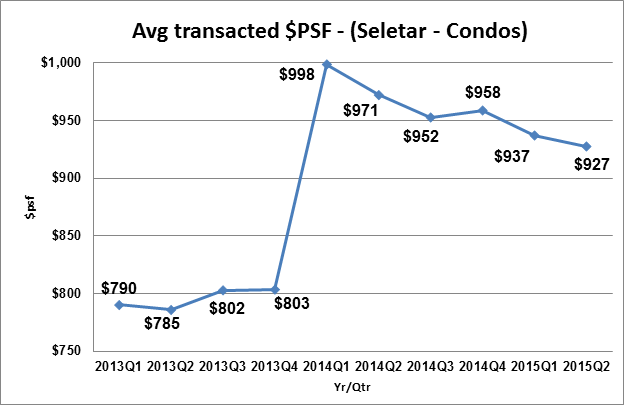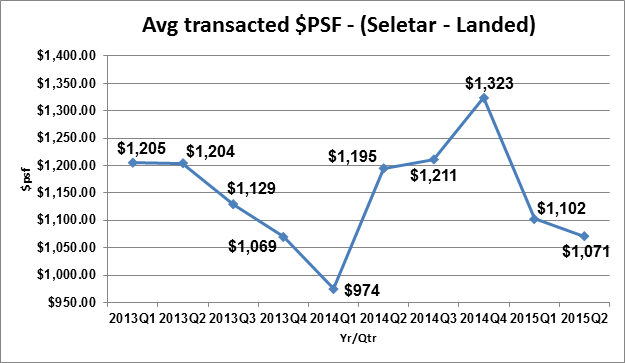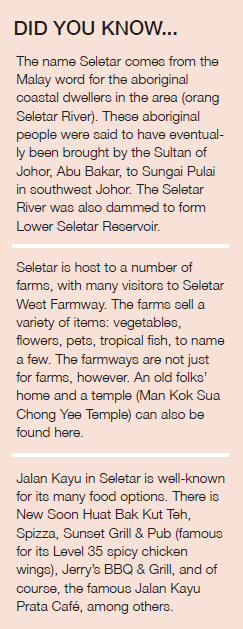Seletar may be one of Singapore’s older estates, but it is experiencing new life with its transformation into one of the country’s regional centres.
By Cheryl Marie Tay
Seletar is known for its abundance of greenery, landed homes, and of course, Seletar Airport and Seletar River. As one of the older residential estates in Singapore, it is not as commercialized or developed as newer estates like Punggol and Sengkang.
But Seletar has its gems, too: different types of farms, a delectable selection of food along Jalan Kayu, and the peaceful neighbourhood of Seletar Hills are just some of its attractive features.
Furthermore, plans are already underway to transform Seletar into one of Singapore’s regional centres, alongside Tampines, Woodlands and Jurong.
Historically speaking
Seletar is an area rich in history. Though post-independence Singapore will be celebrating its much-hyped 50th anniversary only this year, the history of Seletar itself dates back to the 1840s, with Seletar Road, now Thomson Road, having first been cut then. The estate was a swampy, hilly one, with many rubber trees and mangrove swamps dotting its landscape.
In 1921, the decision was made to construct the British air and naval bases in Seletar, with work commencing six years later. This meant removing several hills, felling rubber trees, and filling in mangrove swamps in the area. When the works were completed in the early 1930s, Royal Air Force (RAF) Seletar became the first RAF base east of India, as well as the first civilian airport in Singapore; it operated from 1928 to 1971. RAF Seletar (commonly called Seletar Airport) served as a civil airport from 1930 onwards, used mainly by the British. In fact, it was Singapore’s only airport before Kallang Airport was opened in 1937.
Despite the estate’s somewhat depleted natural features following the completion of RAF Seletar, not all was lost on that front. In 1935, works started on building Seletar Reservoir, known today as Upper Seletar Reservoir.
Here and now
Today, Seletar Airport functions as a general aviation airport, largely chartered flights. It is also used for training purposes, accommodating the Republic of Singapore Flying Club, Seletar Flying Club, Singapore Youth Flying Club and Singapore Flying College.
But apart from aviation and nature, Seletar’s development as a residential estate has come a long way. Although it is not as built up as its neighbour Sengkang, Seletar boasts sufficient amenities to support its residential developments. Shopping malls such as The Seletar Mall and Greenwich V, with their myriad of offerings, provide residents with the coveted combination of convenience and choice.
Convenience aside, Seletar’s home prices are attractive. Eugene Lim, Key Executive Officer at ERA, says: “Housing prices in Seletar are relatively low now, compared to neighbouring housing estates. At the recently launched High Park Residences, more than 1,000 units were sold at an average price of $970 psf. In comparison, condominium units in Sengkang are transacting at average prices of $1,080 psf.”
For home buyers with a bigger budget and a preference for larger living spaces, the abundance of landed homes in the area can meet their needs. From terraced houses on Springside Avenue to semi-detached homes on Begonia Drive and even cluster homes on Nim Road, Seletar is teeming with different types of landed housing amid its lush, expansive greenery.
As Lim says, “All in all, Seletar is a self-sufficient estate, has growth potential, and (its) current home prices are not expensive. All these factors come together to make Seletar an attractive estate.”
On the horizon
Seletar has been earmarked for future development by the Urban Redevelopment Authority (URA), with the impending third phase of the Seletar Aerospace Park, and Seletar to become the fourth regional centre in Singapore, after Woodlands, Jurong and Tampines. Seletar Aerospace Park currently has Europcoter, Rolls-Royce Group and ST Aerospace on its list of tenants, and Phase 3 promises to create 10,000 jobs, many of which will be career opportunities for highly-skilled employees.
An improved and greater variety of housing choices is yet another feature of the URA’s plan for Seletar’s development, with low- to medium-rise, as well as high-rise housing projects underway. In keeping with the estate’s emphasis on nature, neighbourhood parks in and around Seletar will be built. This includes a park in Jalan Kayu, which will also enjoy further landscaping, and receive a new pedestrian pavement.
However, even as detailed future plans for Seletar are being set in motion, its past is also being preserved. Two buildings in The Oval, as well as two former military buildings in Seletar, have been conserved. The colonial buildings will be repurposed for commercial use, with shops and eateries to capitalize on the area’s prominent features.
Future homes
Among the upcoming residential developments in Seletar are Riverbank@Fernvale and Seletar Park Residence. The former, developed by UOL Group, is a 99-year leasehold condominium with 555 units across four 19-storey blocks. According to Lim, “(Its) main selling point is its vantage views. Over 90 percent of (its) homes would have unblocked views of Sungei Punggol. In addition, launch prices are low, generally below $1,000 psf.”
Similarly, the latter is a 99-year leasehold condo. With 276 units across five-storey blocks, however, it accommodates significantly fewer residents. Lim says: “Seletar Park Residence units are sold at a higher unit price of about $1,134 psf. The project’s main selling point is its design; with its low-rise blocks, the entire project is quite resort-like. However, it must be noted that it was launched in 2012, before the Total Debt Servicing Ratio (TDSR) was introduced, hence the higher prices.”
Expert advice
While Seletar’s residential market seems positive, government regulations have significantly restricted both buyers and sellers. Lim cautions: “Homeowners looking to sell should be aware that buyers are affected by the TDSR, which severely restricts their purchasing power. Hence, it is quite difficult for sellers to achieve any premium above market price. Home buyers should take their time before making a decision. Given that there are about 10 condos in the area, buyers should visit each one before deciding.”
Still, the future of Seletar is promising: “Seletar has growth potential, especially since it is relatively under-developed now. Much of its growth will happen progressively, as the government will focus on Woodlands first, then Seletar. A property in Seletar is a longer-term investment with good upside potential once growth occurs.”
 |
This article was first published in the print version The PropertyGuru News & Views. Download PDF of full print issues or read more stories now! | ||



